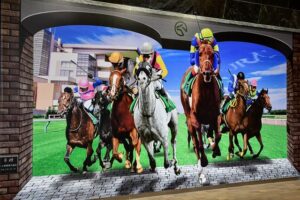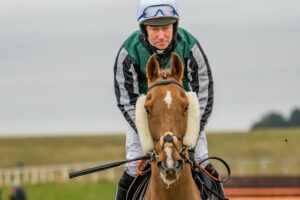Thomas Geoffrey ‘Tom’ Scudamore announced his shock retirement, with immediate effect, on February 16, 2023, shortly after being unseated from Ya Know Yaseff, trained by David Pipe, in a novices’ handicap chase at Leicester. Scudamore had previously suffered concussion when his mount, Royal Defender, was brought down in a ‘bumper’ at Chepstow on February 3 and, having received ‘a right kicking’ at Leicester, he had few qualms about hanging up his boots. Reflecting on his spur-of-the-moment decision, Scudamore said, ‘At my age [40] you have to be careful. I feel I have had a bit of a warning.’
Scudamore, the son of eight-time champion National Hunt jockey Peter, rode his last winner, Pachacuti, also trained by Pipe, in a handicap hurdle at Fakenham on February 2, 2023. All told, he rode 1,499 winners under National Hunt Rules, all bar one on British soil, making him the tenth most profilic Jump jockey of all time in Great Britain and Ireland. He enjoyed his most successful season, numerically, in 2014/15, when he rode 150 winners and finished third in the National Hunt Jockeys’ Championship.
Scudamore effectively rode his first ‘winner’ of any description, Nordic Breeze, trained by Martin Pipe, in an amateur riders’ handicap on the Flat at Warwick on July 3, 1998. However, Nordic Breeze, who was beaten five lengths, was only awarded the race after an investigation by the British Amateur Jockeys’ Association revealed that the first past the post, Broughtons Lure, was ridden by former American professional Angel Monserrate, masquerading as amateur ‘Angel Jacobs’.
Over obstacles, Scudamore rode his first winner, Young Thruster, trained by Nigel Twiston-Davies, in an amatuer riders’ novices’ hurdle at Newton Abbott on November 4, 1998. He was champion amateur rider in 2000/01 and, having turned professional, rode his first winner in the paid ranks, Belle D’Anjou, also trained by Martin Pipe, in a handicap hurdle at Chepstow on October 6, 2001.

 On February 9, 2017, an inquest at Westminster Coroner’s Court heard that Walter Robert John Swinburn died on December 12, 2016 after suffering a fatal head injury in a fall from the bathroom window of his maisonette in Belgravia, Central London. He was found, wearing just his underwear, by his father, former Irish champion jockey Walter Robert ‘Wally’ Swinburn, on a courtyard 12 feet below the window but, while police and paramedics attended, he was pronounced.
On February 9, 2017, an inquest at Westminster Coroner’s Court heard that Walter Robert John Swinburn died on December 12, 2016 after suffering a fatal head injury in a fall from the bathroom window of his maisonette in Belgravia, Central London. He was found, wearing just his underwear, by his father, former Irish champion jockey Walter Robert ‘Wally’ Swinburn, on a courtyard 12 feet below the window but, while police and paramedics attended, he was pronounced. Of course, the Derby Stakes was famously founded by Sir Charles Bunbury and Edward Smith-Stanley, the Twelfth Earl of Derby, in 1780 and reputedly named in honour of the latter after a (probably apocryphal) coin toss between the pair. The race has always been run at Epsom Downs Racecourse in Surrey, but the first four renewals were staged on a straight, one-mile course; the wide, sweeping, left-handed turn into the straight, known as Tattenham Corner, did not become a feature of the Derby course until 1784, when the distance was extended to a mile and a half. Similarly, the Derby has always been open to three-year-old thoroughbred colts and fillies, although nowadays the race conditions stipluate ‘entire’ colts only; geldings have been excluded since 1904.
Of course, the Derby Stakes was famously founded by Sir Charles Bunbury and Edward Smith-Stanley, the Twelfth Earl of Derby, in 1780 and reputedly named in honour of the latter after a (probably apocryphal) coin toss between the pair. The race has always been run at Epsom Downs Racecourse in Surrey, but the first four renewals were staged on a straight, one-mile course; the wide, sweeping, left-handed turn into the straight, known as Tattenham Corner, did not become a feature of the Derby course until 1784, when the distance was extended to a mile and a half. Similarly, the Derby has always been open to three-year-old thoroughbred colts and fillies, although nowadays the race conditions stipluate ‘entire’ colts only; geldings have been excluded since 1904. Who hasn’t heard of Frankie Dettori? Probably one of the most popular race riders ever to have ridden a horse in the UK.
Who hasn’t heard of Frankie Dettori? Probably one of the most popular race riders ever to have ridden a horse in the UK.